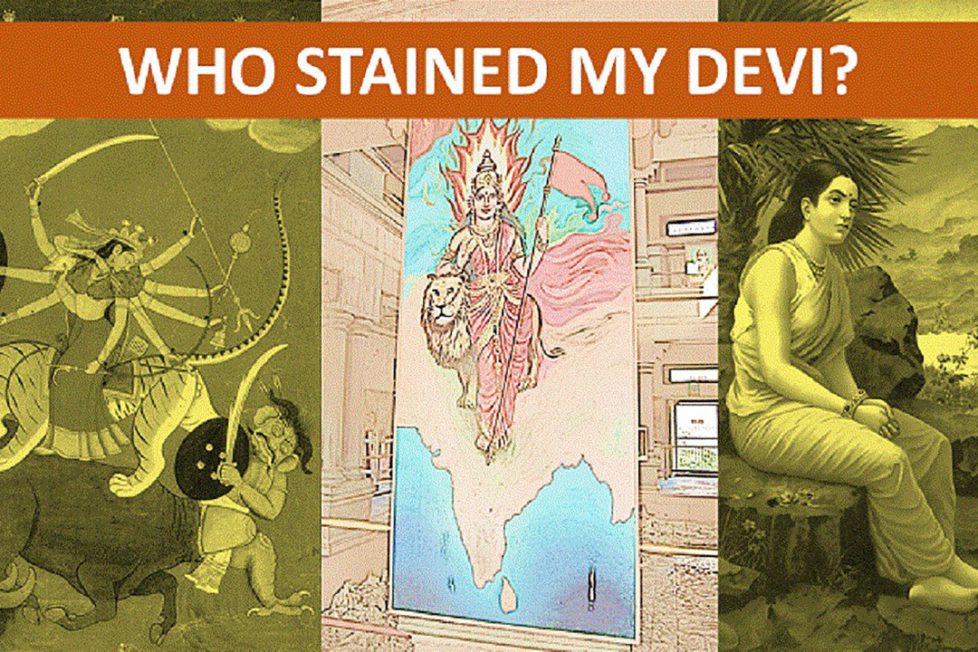Who Stained My Devi?


As someone who has closely observed the modus operandi of the Left, I am no more surprised when the cabal indulges in selective observation, outrage or outreach. For an ecosystem that is infested with delirious historians and deranged activists, it is only obvious that they believe the world is as flippant as them to believe in their cherry-picked data and inventive history. However, it would be breach of intellectual integrity on my part, if I remain silent on the motivated campaign being run by ideological mouthpieces of the Left, to smear Indian culture with charges of misogyny and violation of women rights. From Audrey Truschke selling a cart full of lies with tacit support from the Congress, which provides her a legitimate platform to inane comedians, the web of trickery is complicated and dangerous too.
I attempt to reduce disparaging arguments that are oft used to paint India as a land of patriarchy and contest their fictional claim i.e. Indian culture is misogynist by any stretch of imagination.
Myth 1: Manusmriti says ‘Women Don’t Deserve Independence’
The phrase “न स्त्री स्वातन्त्र्यमर्हति” from Manusmriti is often misinterpreted. It does not mean “a woman does not deserve freedom”; “स्वातन्त्र्यमर्हति” here refers to self-dependence. Manu here poses the society with the responsibility to take care of sustenance of a woman, who according to him is divine and deserves protection, security, well-being, nourishment and upkeep. He makes a case of collective responsibility towards economic and social dignity of women, so that individuals do not resort to flippant behaviour with women.
Myth 2: Women have been consistently denied choice and their consent is never sought for anything
Myth 3: Sita was a victim of Ram’s Righteousness
It is frequently communicated by liberal pro-choice commentators that Sita was forced to accompany Ram because she was his ardhangini (better half). In the following chaupai from Ramcharitmanas, Ram discourages Sita from accompanying him to the forest on account of the natural hardships.
कुस कंटक मग काँकर नाना। चलब पयादेहिं बिनु पदत्राना
चरन कमल मृदु मंजु तुम्हारे। मारग अगम भूमिधर भारे॥
However, in the subsequent chaupai, Sita asserted her choice and argued for equality in the relationship as a reason to accompany Ram to the arduous exile.
को प्रभु सँग मोहि चितवनिहारा। सिंघबधुहि जिमि ससक सिआरा
मैं सुकुमारि नाथ बन जोगू। तुम्हहि उचित तप मो कहुँ भोगू॥
Sita asserted her will to accompany Ram to exile, despite visible resistance from her husband and family. A trained horse-rider, she was an equal in her husband’s journey.
Last, but not the least, how can any motivated intellect determined to defect the Hindu culture, stay away from illustrating the unfortunate incident when pregnant Sita was sent to Valmiki’s ashram and eventually frame Ram as a misogynist who ‘abandoned’ his wife. This selective reading of the text has crossed all boundaries of intellectual integrity for two reasons; one, when Ram decided to send Sita to Valmiki’s ashram, he was merely following the law of land, disregard for which would otherwise make him a biased ruler of self-convenience. Moreover, bound by his ek patni vrat, Ram himself too suffered in Sita viyog and refused to indulge in worldly pleasures.
Now let us plot women across the Indian spectrum, who represent empowerment, independence, strength and equality in their own right such as Lopamudra who wrote Lalitha Sahasranama with Rishi Agastya, Maitreyi an intellectual giant, Kaikeyi an exemplary warrior, Chitrangada another warrior princess etc. etc. Women were trained in all 64 Kalas, and no discrimination was made until the invasion of Indic commenced.
Right from purdah and female foeticide to protect their daughters from foreigners, to Sati to protect widows from invaders – most of the loathsome trends are a recent phenomenon, born as a consequence of changing demographic and cultural fabric of the sub-continent.
The following shloka reinstates the significance of women in Indian scriptures; all actions are futile in a society where women are not respected.
यत्र नार्यस्तु पूज्यन्ते रमन्ते तत्र देवताः
यत्रैतास्तु न पूज्यन्ते सर्वास्तत्राफलाः क्रियाः॥
Rig Veda advocates for all those aspects that feminists today resort to drive their progressive viewpoints, including inheritance rights for daughters, women education, role of women in governance, politics.
While it is heartening to see liberals acknowledge Ramayana, Mahabharat and Manusmriti as an integral part of Indian culture (even if it is for political posturing or to reject the progressive curve of India’s social evolution) I am hopeful they will get rid of the selective blinders, which prevent them from seeing eye to eye with facts and objective analysis. I would urge all scholars who claim to be Indic experts start from the hypothesis, that Devi is nature and nothing can sustain without nature.
DISCLAIMER: The author is solely responsible for the views expressed in this article. The author carries the responsibility for citing and/or licensing of images utilized within the text.
1 Comment
You must be logged in to post a comment.

Amazing article by Gunja Ma’am on how Dharmic culture of India actually stands for Women of Bharat! 🙂